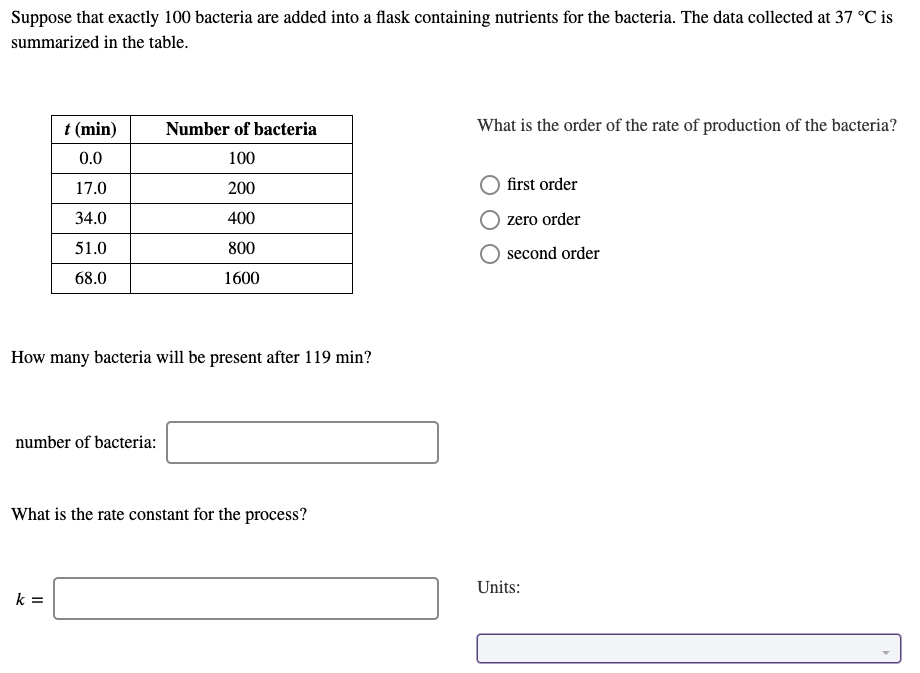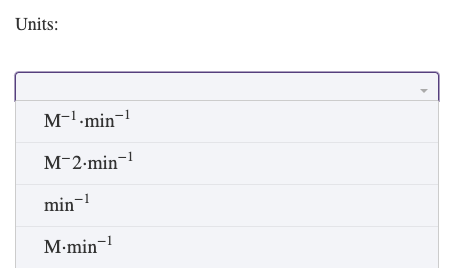Suppose that exactly 100 bacteria are added into a flask containing nutrients for the bacteria. The data collected at 37 °C is summarized in the table. t (min) Number of bacteria What is the order of the rate of production of the bacteria? 0.0 100 17.0 200 first order 34.0 400 zero order 51.0 800 second order 68.0 1600 How many bacteria will be present after 119 min? number of bacteria: What is the rate constant for the process? Units: k =
Suppose that exactly 100 bacteria are added into a flask containing nutrients for the bacteria. The data collected at 37 °C is summarized in the table. t (min) Number of bacteria What is the order of the rate of production of the bacteria? 0.0 100 17.0 200 first order 34.0 400 zero order 51.0 800 second order 68.0 1600 How many bacteria will be present after 119 min? number of bacteria: What is the rate constant for the process? Units: k =
Chemistry & Chemical Reactivity
9th Edition
ISBN:9781133949640
Author:John C. Kotz, Paul M. Treichel, John Townsend, David Treichel
Publisher:John C. Kotz, Paul M. Treichel, John Townsend, David Treichel
Chapter14: Chemical Kinetics: The Rates Of Chemical Reactions
Section: Chapter Questions
Problem 12PS: The reaction 2 NO(g) + 2 H2(g) N2(g) + 2 H2O(g) was studied at 904 C, and the data in the table...
Related questions
Question
100%

Transcribed Image Text:Suppose that exactly 100 bacteria are added into a flask containing nutrients for the bacteria. The data collected at 37 °C is
summarized in the table.
t (min)
Number of bacteria
What is the order of the rate of production of the bacteria?
0.0
100
17.0
200
first order
34.0
400
zero order
51.0
800
second order
68.0
1600
How many bacteria will be present after 119 min?
number of bacteria:
What is the rate constant for the process?
Units:
k =

Transcribed Image Text:Units:
M-l-min-1
M-2-min-
min
M-min-!
Expert Solution
This question has been solved!
Explore an expertly crafted, step-by-step solution for a thorough understanding of key concepts.
This is a popular solution!
Trending now
This is a popular solution!
Step by step
Solved in 3 steps with 1 images

Knowledge Booster
Learn more about
Need a deep-dive on the concept behind this application? Look no further. Learn more about this topic, chemistry and related others by exploring similar questions and additional content below.Recommended textbooks for you

Chemistry & Chemical Reactivity
Chemistry
ISBN:
9781133949640
Author:
John C. Kotz, Paul M. Treichel, John Townsend, David Treichel
Publisher:
Cengage Learning

Chemistry & Chemical Reactivity
Chemistry
ISBN:
9781337399074
Author:
John C. Kotz, Paul M. Treichel, John Townsend, David Treichel
Publisher:
Cengage Learning

Chemistry: The Molecular Science
Chemistry
ISBN:
9781285199047
Author:
John W. Moore, Conrad L. Stanitski
Publisher:
Cengage Learning

Chemistry & Chemical Reactivity
Chemistry
ISBN:
9781133949640
Author:
John C. Kotz, Paul M. Treichel, John Townsend, David Treichel
Publisher:
Cengage Learning

Chemistry & Chemical Reactivity
Chemistry
ISBN:
9781337399074
Author:
John C. Kotz, Paul M. Treichel, John Townsend, David Treichel
Publisher:
Cengage Learning

Chemistry: The Molecular Science
Chemistry
ISBN:
9781285199047
Author:
John W. Moore, Conrad L. Stanitski
Publisher:
Cengage Learning

Chemistry: Matter and Change
Chemistry
ISBN:
9780078746376
Author:
Dinah Zike, Laurel Dingrando, Nicholas Hainen, Cheryl Wistrom
Publisher:
Glencoe/McGraw-Hill School Pub Co

Chemistry: An Atoms First Approach
Chemistry
ISBN:
9781305079243
Author:
Steven S. Zumdahl, Susan A. Zumdahl
Publisher:
Cengage Learning

Chemistry
Chemistry
ISBN:
9781305957404
Author:
Steven S. Zumdahl, Susan A. Zumdahl, Donald J. DeCoste
Publisher:
Cengage Learning